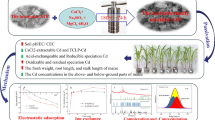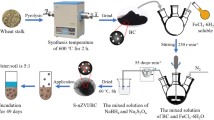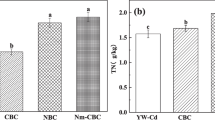Abstract
Aim of this work was to synthesize mercapto-modified attapulgite (ATP-SH) and explore the effectiveness and mechanism of ATP-SH on the remediation of Cd-contaminated soil. The ATP-SH was applied to the remediation of cadmium contaminated soil with a concentration of 5.48 mg/kg through pot rice experiment. The changes of soil physicochemical properties, Cd content in rice and straw, available Cd, and different speciation of Cd in soil were studied after the addition of ATP-SH. Some methods, such as XRD, FTIR, and XPS, confirmed successfully grafting of the mercapto. The addition of ATP-SH has little effect on the major physicochemical properties of soil. Compared to the blank group (CK), with the increase of ATP-SH dosage, the available Cd content in soil and the Cd content in rice and straw decrease significantly, and the maximum reduction rates are 73.1%, 92.6%, and 85.7%, respectively; the exchangeable Cd (EX-Cd) and carbonate bound Cd (CAR-Cd) in soil decrease significantly, while Fe/Mn oxide bound Cd (FMO-Cd) and strong organic bound Cd (SO-Cd) increase significantly. Combined with a large number of previous conclusions, we believe that the Si-2p and Al-2p electron clouds in ATP-SH transfer and change the electronic properties of iron, thus increasing the adsorption of Cd on its surface, and then coating to form FMO-Cd, and there are a large number of sulfhydryl and hydroxyl on the surface of the material, which have strong bonding effect on Cd to form SO-Cd. The application of ATP-SH could effectively reduce the content of Cd in straw and rice by the synergistic effect of ATP, S, and Fe rather than increasing soil pH to stabilize heavy metals. It is an efficient remediation agent for Cd-contaminated paddy soil with a good practical application prospect.









Similar content being viewed by others
Data Availability
The datasets used and/or analyzed during the current study are available from the corresponding author on reasonable request.
References
Ali, H., Khan, E., & Sajad, M. A. (2013). Phytoremediation of heavy metals-Concepts and applications. Chemosphere, 91(7), 869–881.
Antoniadis, V., & Damalidis, K. (2012). Dimirkou A (2012) Availability of Cu and Zn in an acidic sludge-amended soil as affected by zeolite application and liming. J Soils Sediment, 12(3), 396–401.
Babel, S., & Kurniawan, T. A. (2003). Low-cost adsorbents for heavy metals uptake from contaminated water: A review. Journal of Hazardous Materials, 97(1–3), 219–243.
Bu, X., Zhang, G., & Guo, Y. (2011). Thermal modified palygorskite: Preparation, characterization, and application for cationic dye-containing wastewater purification. Desalination and Water Treatment, 30(1–3), 339–347.
Chen, Z., Feng, X. J., & Zhu, Y. C. (2020). Study on the passivation effect of natural and modified attapulgite on heavy metal lead in soils of the rare earth tailings. Rock and Mineral Analysis, 39(06), 847–855. (in Chinese).
Eusterhues, K., Wagner, F. E., Häusler, W., et al. (2008). Characterization of ferrihydrite-soil organic matter coprecipitates by X-ray diffraction and Mossbauer spectroscopy. Environmental Science and Technology, 42(21), 7891–7897.
Fu, C., Zhu, X., Dong, X., Zhao, P., Wang, Z. (2020). Study of adsorption property and mechanism of lead (II) and cadmium (II) onto sulfhydryl modified attapulgite. Arabian Journal of Chemistry,14(2), 102960–102969.
Gu, J. F., Zhou, H., Yang, W. T., et al. (2018). Effects of an additive (hydroxyapatite-biochar-zeolite) on the chemical speciation of Cd and As in paddy soils and their accumulation and translocation in rice plants. Environ Sci Pollut R, 25(9), 8608–8619.
Guo, G., Lei, M., Wang, Y., et al. (2018). Accumulation of As, Cd, and Pb in sixteen wheat cultivars grown in contaminated soils and associated health risk assessment. Int J Env Res Pub He, 15(11), 2601.
Hale, S. E., Lehmann, J., Rutherford, D., et al. (2012). Quantifying the total and bioavailable polycyclic aromatic hydrocarbons and dioxins in biochars. Environmental Science and Technology, 46(5), 2830–2838.
He, Y. T., Li, H., Xie, H. L., et al. (2019). Cadmium accumulation, yield and quality of different rice varieties under mild cadmium stress. Sichuan Agricultural Science and Technology, 07, 40–43. (in Chinese).
Huang, M., Li, Z., Luo, N., et al. (2019). Application potential of biochar in environment: Insight from degradation of biochar-derived DOM and complexation of DOM with heavy metals. Science of the Total Environment, 646, 220–228.
Kypritidou, Z., & Argyraki A. (2021). Geochemical interactions in the trace element-soil-clay system of treated contaminated soils by Fe-rich clays. Environmental Geochemistry Health, 43(7), 2483–2503.
Li, J., & Xu, Y. (2018). Evaluation of palygorskite for remediation of Cd-polluted soil with different water conditions. J Soils Sediment, 18(2), 526–533.
Li, L. F., Ai, S. Y., Wang, Y. H., et al. (2016). In situ field-scale remediation of low Cd-contaminated paddy soil using soil amendments. Water Air Soil Poll, 227(9), 1–10.
Li, F., Shen, W., Wu, X., et al. (2020a). Remediation of heavy metal contaminated soil by passivation of biochar complex minerals. Chinese Journal of Soil Science, 51(1), 195–200. (in Chinese).
Li, J., Chen, S., Gao, X. J., et al. (2020b). Study on remediation of Cd contaminated soil and reduction of chinese cabbage Cd pollution risk by soil amendments. Environmental Science and Management, 45(08), 78–82. (in Chinese).
Liang, X., Han, J., Xu, Y., et al. (2014). Sorption of Cd2+ on mercapto and amino functionalized palygorskite. Applied Surface Science, 322, 194–201.
Liang, X., Xu, Y., Xu, Y., et al. (2016). Two-year stability of immobilization effect of sepiolite on Cd contaminants in paddy soil. Environ Sci Pollut R, 23(13), 12922–12931.
Liang, X., Qin, X., Huang, Q., et al. (2017). Remediation mechanisms of mercapto-grafted palygorskite for cadmium pollutant in paddy soil. Environ Sci Pollut R, 24(30), 23783–23793.
Liang, X., Li, N., He, L., et al. (2019). Inhibition of Cd accumulation in winter wheat (Triticum aestivum L.) grown in alkaline soil using mercapto-modified attapulgite. Science of the Total Environment, 688, 818–826.
Liu, H. B., Chen, T. H., Chang, D. Y., et al. (2013). The difference of thermal stability between Fe-substituted palygorskite and Al-rich palygorskite. Journal of Thermal Analysis and Calorimetry, 111(1), 409–415.
Lu, R. K. (1999). Analytical methods for soils and agricultural chemistry. China Agricultural Science and Technology Press. (in Chinese).
Mo, X. X., Siebecker, O., Gou, M., et al. (2021). A review of cadmium sorption mechanisms on soil mineral surfaces revealed from synchrotron-based X-ray absorption fine structure spectroscopy: Implications for soil remediation. Pedosphere, 31(1), 11–27.
Moreira, M. A., Ciuffi, K. J., Rives, V., et al. (2017). Effect of chemical modification of palygorskite and sepiolite by 3-aminopropyltriethoxisilane on adsorption of cationic and anionic dyes. Applied Clay Science, 135, 394–404.
Ok, Y. S., Kim, S. C., Kim, D. K., et al. (2011). Ameliorants to immobilize Cd in rice paddy soils contaminated by abandoned metal mines in Korea. Environ Geochem Hlth, 33, 23–30.
Qu, F., Fan, C., Liu, G., et al. (2019). Effects of different passivating agents on the effective state of heavy metals in typical yellow soil in Guizhou. Journal of Southern Agriculture, 50(9), 1967–1972. (in Chinese).
Ram, L. C., & Masto, R. E. (2014). Fly ash for soil amelioration: A review on the influence of ash blending with inorganic and organic amendments. Earth Science Reviews, 128, 52–74.
Schaefer, M. V., Gorski, C. A., & Scherer, M. M. (2011). Spectroscopic evidence for interfacial Fe (II)− Fe (III) electron transfer in a clay mineral. Environmental Science and Technology, 45(2), 540–545.
Sneath, H. E., Hutchings, T. R., & de Leij, F. A. (2013). Assessment of biochar and iron filing amendments for the remediation of a metal, arsenic and phenanthrene co-contaminated spoil. Environmental Pollution, 178, 361–366.
Song, B., Zeng, G. M., Gong, J. L., et al. (2017). Evaluation methods for assessing effectiveness of in situ remediation of soil and sediment contaminated with organic pollutants and heavy metals. Environment International, 105, 43–55.
Sun, Y., Sun, G., Xu, Y., et al. (2012). In situ stabilization remediation of cadmium contaminated soils of wastewater irrigation region using sepiolite. Journal of Environmental Sciences, 24(10), 1799–1805.
Uddin, M. K. (2017). A review on the adsorption of heavy metals by clay minerals, with special focus on the past decade. Chemical Engineering Journal, 308, 438–462.
Vareda, J. P., Valente, A. J. M., & Duraes, L. (2019). Assessment of heavy metal pollution from anthropogenic activities and remediation strategies: A review. Journal of Environmental Management, 246, 101–118.
Wang, W., Tian, G., Zhang, Z., et al. (2015). A simple hydrothermal approach to modify palygorskite for high-efficient adsorption of methylene blue and Cu(II) ions. Chemical Engineering Journal, 265, 228–238.
Wang, L., Ji, B., Hu, Y., et al. (2017). A review on in situ phytoremediation of mine tailings. Chemosphere, 184, 594–600.
Wang, Y. L., Xu, Y. M., Qin, X., et al. (2020a). Effect of simulated acid rain on the remediation of Cd-contaminated soil by mercapto-palygorskite. Environmental Science & Technology, 43(02), 33–40. (in Chinese).
Wang, Y. L., Xu, Y. M., Peng, Y., et al. (2020b). Control effects of column leaching combined with mercapto-modified palygorskite immobilization on weakly alkaline Cd and Pb-contaminated soils. Journal of Agro-Environment Science, 39(1), 78–86. (in Chinese).
Wu, G., Kang, H., Zhang, X., et al. (2010). A critical review on the bio-removal of hazardous heavy metals from contaminated soils: Issues, progress, eco-environmental concerns and opportunities. Journal of Hazardous Materials, 174(1–3), 1–8.
Yang, R., Li, D. W., Li, A. M., et al. (2018). Adsorption properties and mechanisms of palygorskite for removal of various ionic dyes from water. App Clay Sci, 151, 20–28.
Yang, H., Zhang, G., Fu, P., et al. (2020). The evaluation of in-site remediation feasibility of Cd-contaminated soils with the addition of typical silicate wastes. Environmental Pollution, 265, 114865.
Yao, D., Shi, Y., Pan, H., et al. (2020). Promotion mechanism of natural clay colloids in the adsorption of arsenite on iron oxide particles in water. Chemical Engineering Journal, 392, 123637.
Zha, F., Huang, W., Wang, J., et al. (2013). Kinetic and thermodynamic aspects of arsenate adsorption on aluminum oxide modified palygorskite nanocomposites. Chemical Engineering Journal, 215, 579–585.
Zhang, C., Ge, Y., Yao, H., et al. (2012). Iron oxidation-reduction and its impacts on cadmium bioavailability in paddy soils: A review. Front Env Sci Eng, 6(4), 509–517.
Zhang X, Wang X, Wang D (2017) Immobilization of heavy metals in sewage sludge during land application process in China: A review. Sustainability 9(11): 2020
Zhao, Z., Fu, D., & Ma, Q. (2014). Adsorption characteristics of bisphenol A from aqueous solution onto HDTMAB-modified palygorskite. Separation Science and Technology, 49(1), 81–89.
Zhao, F. J., Ma, Y., Zhu, Y. G., et al. (2015). Soil contamination in China: Current status and mitigation strategies. Environmental Science and Technology, 49(2), 750–759.
Zhao, M., Liu, X., Li, Z., et al. (2021). Inhibition effect of sulfur on Cd activity in soil-rice system and its mechanism. Journal of Hazardous Materials, 407, 124647.
Zhu X P, Fu C, Lei N F, et al. Sulfhydryl functionalized attapulgite and its preparation method [P]. China, CN109046260B, 2021–06–04.
Funding
We gratefully acknowledge the financial support from the Science and Technology Department of Guizhou Province ([2019]2833 and [2019]1424). We also gratefully acknowledge the financial support from Sichuan Bureau of Geology and Mineral Resources (KJCX-2020–007).
Author information
Authors and Affiliations
Contributions
Xiaping Zhu, Ying Zeng, Ningfei Lei: conceptualization, methodology.
Guangxi He: writing—original draft preparation. Yan An, Yuying Chen: software, validation.
Cheng Fu: data curation. Junya Li: visualization, investigation. Zepeng Wang: supervision.
Xiaping Zhu, Ping Zhao: writing—reviewing and editing.
Corresponding authors
Ethics declarations
Ethics Approval and Consent to Participate
Ethics approval and informed consent do not apply for this study. We confirm that this manuscript has not been published elsewhere and is not under consideration by another journal.
Consent for Publication
Not applicable.
Competing Interests
The authors declare no competing interests.
Additional information
Publisher's Note
Springer Nature remains neutral with regard to jurisdictional claims in published maps and institutional affiliations.
Supplementary Information
Below is the link to the electronic supplementary material.
Rights and permissions
Springer Nature or its licensor holds exclusive rights to this article under a publishing agreement with the author(s) or other rightsholder(s); author self-archiving of the accepted manuscript version of this article is solely governed by the terms of such publishing agreement and applicable law.
About this article
Cite this article
He, G., Zhu, X., An, Y. et al. Study on the Effectiveness and Mechanism of Mercapto-Modified Attapulgite for Remediation of Cadmium-Contaminated Paddy Soil. Water Air Soil Pollut 233, 397 (2022). https://doi.org/10.1007/s11270-022-05853-w
Received:
Accepted:
Published:
DOI: https://doi.org/10.1007/s11270-022-05853-w




